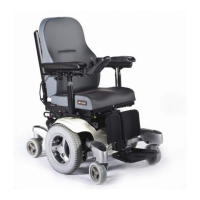12.8 The range of your vehicle
Please refer to the specification tables at the back of this
manual for Energy Consumption, (Maximum Range),
information.
Most manufacturers of mobility products state the range
of their vehicles either in the sales literature or within
the Owner’s Manual. The range stated sometimes
differs from manufacturer to manufacturer even
though the battery size is the same. Sunrise Medical
measure the range of their vehicles in a consistent and
uniform manner, but variances still occur due to motor
efficiencies and overall product load weight.
The range figures are calculated to I.S.O. Standard
7176. Part 4: Wheelchair Energy Consumption
Theoretical Range
This test is carried out in controlled conditions with new,
fully charg ed batteries, on a level test surface and a user
weight of
100 kg. The range figures stated should be seen as a
theoretical maximum and could be reduced if any single,
or combination, of the following circumstances occur:
User weight heavier than 100 kg.•
Batteries whose age and condition are less than •
perfect.
The terrain is difficult e.g. very hilly, sloping, muddy •
ground, gravel, grass, snow and ice.
The vehicle climbs kerbs regularly.•
The ambient temperature is very hot or very cold.•
Incorrect tyre pressures in one or more tyres.•
Lots of start/stop driving.•
Also thick pile carpets within the home can affect •
range.
Use of additional power consumption options (e.g. •
light, actuators, etc.)
The battery sizes available on each Sunrise Medical
product should give sufficient range to cope with the
majority of customer’s lifestyles.
12.9 Battery warranty
Battery warranties are subject to periods set by the
manufacturers. However, most of these warranties are
subject to a wear and tear clause, and if you genuinely
wear out your batteries in 6 months, it will not be possible
to obtain a replacement under warranty.
WARNINGS!
Make sure the cord is located so that it will not be •
stepped on, tripped over or otherwise subjected to
damage or stress.
Do not rest a battery on top of the charger.•
Do not stand the charger on a carpet or other soft •
surface. Always place it on a hard flat surface.
Do not operate the charger if it has received a sharp •
blow, been dropped or otherwise damaged in any
way. Take it to a qualified technician.
Never place the charger directly above the battery •
being charg ed; gases from the battery will corrode
and damage the charger.
Never charge a frozen battery. A fully charged •
battery will rarely freeze but the electrolyte of a
discharged battery can freeze
at -9° Centigrade. Any battery that is suspected of
being frozen should be thawed completely before
charging.
Never sit with the charger on your lap when charging •
your batteries
The charger casing will get hot during its normal •
operation.
Do not disassemble charger; only have it repaired by •
the manufacturers. Incorrect re-assembly may result
in a risk of electric shock or fire.
To reduce the risk of an electric shock, unplug •
the charger from the outlet before attempting any
maintenance or cleaning. Turning off the controls will
not reduce the risk.
Never smoke or allow a spark or flame in the vicinity •
of battery or charger.
Be extra cautious to reduce the risk of dropping a •
metal tool onto the battery. It could spark or short
circuit the battery or other electrical parts that may
cause an explosion. Also take off all personal metal
effects and dangling objects when working on the
battery.

